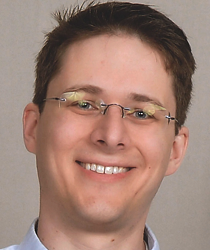
Pascal Getreuer
I am a software engineer in Google Research. My research interests include image and audio processing, inverse problems, and scientific computing.
Research Areas
Authored Publications
Sort By
VHP: Vibrotactile Haptics Platform for On-body Applications
Dimitri Kanevsky
Malcolm Slaney
UIST, ACM, https://dl.acm.org/doi/10.1145/3472749.3474772 (2021)
Preview abstract
Wearable vibrotactile devices have many potential applications, including novel interfaces and sensory substitution for accessibility. Currently, vibrotactile experimentation is done using large lab setups. However, most practical applications require standalone on-body devices and integration into small form factors. Such integration is time-consuming and requires expertise.
To democratize wearable haptics we introduce VHP, a vibrotactile haptics platform. It comprises a low-power, miniature electronics board that can drive up to 12 independent channels of haptic signals with arbitrary waveforms at 2 kHz. The platform can drive vibrotactile actuators including LRAs and voice coils. Each vibrotactile channel has current-based load sensing, thus allowing for self-testing and auto-adjustment. The hardware is battery powered, programmable, has multiple input options, including serial and Bluetooth, as well as the ability to synthesize haptic signals internally. We conduct technical evaluations to determine the power consumption, latency, and how number of actuators that can run simultaneously.
We demonstrate applications where we integrate the platform into a bracelet and a sleeve to provide an audio-to-tactile wearable interface. To facilitate more use of this platform, we open-source our design and partner with a distributor to make the hardware widely available. We hope this work will motivate the use and study of vibrotactile all-day wearable devices.
View details
Image Stylization: From predefined to personalized
Bart Wronski
IET Computer Vision, Computer Vision for the Creative Industries (2020), pp. 14
Preview abstract
We present a framework for interactive design of new image stylizations using a wide range of predefined filter blocks. Both novel and off-the-shelf image filtering and rendering techniques are extended and combined to allow the user to unleash their creativity to intuitively invent, modify, and tune new styles from a given set of filters. In parallel to this manual design, we propose a novel procedural approach that automatically assembles sequences of filters, leading to unique and novel styles. An important aim of our framework is to allow for interactive exploration and design, as well as to enable videos and camera streams to be stylized on the fly. In order to achieve this real-time performance, we use the Best Linear Adaptive Enhancement (BLADE) framework – an interpretable shallow machine learning method that simulates complex filter blocks in real time. Our representative results include over a dozen styles designed using our interactive tool, a set of styles created procedurally, and new filters trained with our BLADE approach.
View details
Fast, Trainable, Multiscale Denoising
Sungjoon Choi
John Isidoro
IEEE International Conference on Image Processing (ICIP) (2018) (to appear)
Preview abstract
Denoising is a fundamental imaging application. Versatile but fast filtering has been demanded for mobile camera systems. We present an approach to multiscale filtering which allows real-time applications on low-powered devices. The key idea is to learn a set of kernels that upscales, filters, and blends patches of different scales guided by local structure analysis. This approach is trainable so that learned filters are capable of treating diverse noise patterns and artifacts. Experimental results show that the presented approach produces comparable results to state-of-the-art algorithms while processing time is orders of magnitude faster.
View details
BLADE: Filter Learning for General Purpose Image Processing
John Isidoro
Sungjoon Choi
Frank Ong
International Conference on Computational Photography (2018)
Preview abstract
The Rapid and Accurate Image Super Resolution (RAISR)
method of Romano, Isidoro, and Milanfar is a computationally efficient image
upscaling method using a trained set of filters. We describe a generalization of
RAISR, which we name Best Linear Adaptive Enhancement (BLADE). This
approach is a trainable edge-adaptive filtering framework that is general, simple,
computationally efficient, and useful for a wide range of image processing
problems. We show applications to denoising, compression artifact removal,
demosaicing, and approximation of anisotropic diffusion equations.
View details
Trainable Frontend For Robust and Far-Field Keyword Spotting
Yuxuan Wang
Thad Hughes
Proc. IEEE ICASSP 2017, New Orleans, LA
Preview abstract
Robust and far-field speech recognition is critical to enable true hands-free communication. In far-field conditions, signals are attenuated due to distance. To improve robustness to loudness variation, we introduce a novel frontend called per-channel energy normalization (PCEN). The key ingredient of PCEN is the use of an automatic gain control based dynamic compression to replace the widely used static (such as log or root) compression. We evaluate PCEN on the keyword spotting task. On our large rerecorded noisy and far-field eval sets, we show that PCEN significantly improves recognition performance. Furthermore, we model PCEN as neural network layers and optimize high-dimensional PCEN parameters jointly with the keyword spotting acoustic model. The trained PCEN frontend demonstrates significant further improvements without increasing model complexity or inference-time cost.
View details
